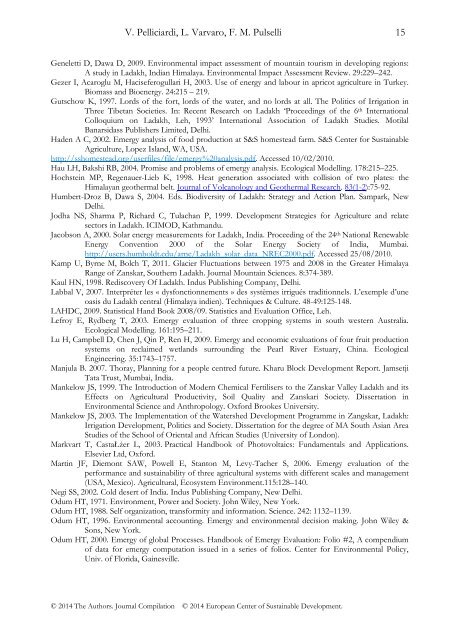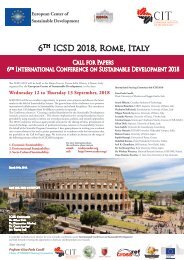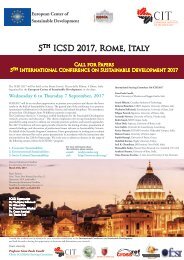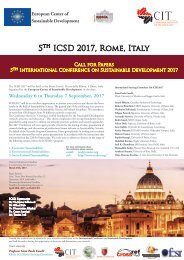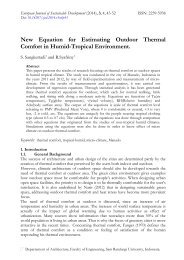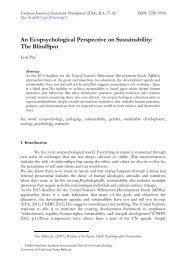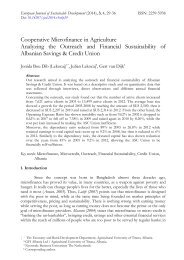Emergy evaluation of a traditional farming system. Case study: Leh District (Ladakh - Indian Trans-Himalaya)
Ladakh traditional farming system has been included on the F.A.O. list of possible “Globally Important Agricultural Heritage Systems”, worthy of being preserved and conserved. The paper describes and assesses cultivation practices in a typical familymanaged farm, located in central Ladakh, analysing how natural resources are exploited, conserved and recycled. Emergy evaluation, an environmental accounting methodology, has been applied to evaluate and compare five staple crop productions: barley, wheat, pea, mustard, and fodder alfalfa. Unit Emergy Values of products (UEV, emergy per unit product, a measure of the environmental production cost) are calculated, taking into account the inputs to production such as water from glaciers, soil fertility, human and animal labour, and more. Results show that the traditional agricultural practices in Ladakh, completely supported by renewable flows, are efficient in the use of local resources. In fact, the UEVs of agroproducts are similar to those of analogous products of conventional agriculture (e.g. 5.27E+05 and 6.64E+05 semj/J for barley and wheat in Ladakh, respectively; 7.37E+05 semj/J for corn in USA), though the inputs of Ladakh agriculture are strongly limited in type and quantity. At the same time, local farmers can create, maintain and rebuild soil functions whose UEV is 1.62E+07 semj/J. Keywords: Ladakh, agrosystem, emergy, environment, sustainability
Ladakh traditional farming system has been included on the F.A.O. list of possible “Globally Important Agricultural Heritage Systems”, worthy of being preserved and
conserved. The paper describes and assesses cultivation practices in a typical familymanaged farm, located in central Ladakh, analysing how natural resources are exploited, conserved and recycled. Emergy evaluation, an environmental accounting methodology, has been applied to evaluate and compare five staple crop productions: barley, wheat, pea, mustard, and fodder alfalfa. Unit Emergy Values of products (UEV, emergy per unit product, a measure of the environmental production cost) are calculated, taking into account the inputs to production such as water from glaciers, soil fertility, human and
animal labour, and more. Results show that the traditional agricultural practices in Ladakh,
completely supported by renewable flows, are efficient in the use of local resources. In fact, the UEVs of agroproducts are similar to those of analogous products of conventional agriculture (e.g. 5.27E+05 and 6.64E+05 semj/J for barley and wheat in Ladakh, respectively; 7.37E+05 semj/J for corn in USA), though the inputs of Ladakh agriculture are strongly limited in type and quantity. At the same time, local farmers can create, maintain and rebuild soil functions whose UEV is 1.62E+07 semj/J.
Keywords: Ladakh, agrosystem, emergy, environment, sustainability
Create successful ePaper yourself
Turn your PDF publications into a flip-book with our unique Google optimized e-Paper software.
V. Pelliciardi, L. Varvaro, F. M. Pulselli 15<br />
Geneletti D, Dawa D, 2009. Environmental impact assessment <strong>of</strong> mountain tourism in developing regions:<br />
A <strong>study</strong> in <strong>Ladakh</strong>, <strong>Indian</strong> <strong>Himalaya</strong>. Environmental Impact Assessment Review. 29:229–242.<br />
Gezer I, Acaroglu M, Haciseferogullari H, 2003. Use <strong>of</strong> energy and labour in apricot agriculture in Turkey.<br />
Biomass and Bioenergy. 24:215 – 219.<br />
Gutschow K, 1997. Lords <strong>of</strong> the fort, lords <strong>of</strong> the water, and no lords at all. The Politics <strong>of</strong> Irrigation in<br />
Three Tibetan Societies. In: Recent Research on <strong>Ladakh</strong> ‘Proceedings <strong>of</strong> the 6 th International<br />
Colloquium on <strong>Ladakh</strong>, <strong>Leh</strong>, 1993’ International Association <strong>of</strong> <strong>Ladakh</strong> Studies. Motilal<br />
Banarsidass Publishers Limited, Delhi.<br />
Haden A C, 2002. <strong>Emergy</strong> analysis <strong>of</strong> food production at S&S homestead farm. S&S Center for Sustainable<br />
Agriculture, Lopez Island, WA, USA.<br />
http://sshomestead.org/userfiles/file/emergy%20analysis.pdf. Accessed 10/02/2010.<br />
Hau LH, Bakshi RB, 2004. Promise and problems <strong>of</strong> emergy analysis. Ecological Modelling. 178:215–225.<br />
Hochstein MP, Regenauer-Lieb K, 1998. Heat generation associated with collision <strong>of</strong> two plates: the<br />
<strong>Himalaya</strong>n geothermal belt. Journal <strong>of</strong> Volcanology and Geothermal Research. 83(1-2):75-92.<br />
Humbert-Droz B, Dawa S, 2004. Eds. Biodiversity <strong>of</strong> <strong>Ladakh</strong>: Strategy and Action Plan. Sampark, New<br />
Delhi.<br />
Jodha NS, Sharma P, Richard C, Tulachan P, 1999. Development Strategies for Agriculture and relate<br />
sectors in <strong>Ladakh</strong>. ICIMOD, Kathmandu.<br />
Jacobson A, 2000. Solar energy measurements for <strong>Ladakh</strong>, India. Proceeding <strong>of</strong> the 24 th National Renewable<br />
Energy Convention 2000 <strong>of</strong> the Solar Energy Society <strong>of</strong> India, Mumbai.<br />
http://users.humboldt.edu/arne/<strong>Ladakh</strong>_solar_data_NREC2000.pdf. Accessed 25/08/2010.<br />
Kamp U, Byrne M, Bolch T, 2011. Glacier Fluctuations between 1975 and 2008 in the Greater <strong>Himalaya</strong><br />
Range <strong>of</strong> Zanskar, Southern <strong>Ladakh</strong>. Journal Mountain Sciences. 8:374-389.<br />
Kaul HN, 1998. Rediscovery Of <strong>Ladakh</strong>. Indus Publishing Company, Delhi.<br />
Labbal V, 2007. Interpréter les « dysfonctionnements » des systèmes irrigués traditionnels. L’exemple d’une<br />
oasis du <strong>Ladakh</strong> central (<strong>Himalaya</strong> indien). Techniques & Culture. 48-49:125-148.<br />
LAHDC, 2009. Statistical Hand Book 2008/09. Statistics and Evaluation Office, <strong>Leh</strong>.<br />
Lefroy E, Rydberg T, 2003. <strong>Emergy</strong> <strong>evaluation</strong> <strong>of</strong> three cropping <strong>system</strong>s in south western Australia.<br />
Ecological Modelling. 161:195–211.<br />
Lu H, Campbell D, Chen J, Qin P, Ren H, 2009. <strong>Emergy</strong> and economic <strong>evaluation</strong>s <strong>of</strong> four fruit production<br />
<strong>system</strong>s on reclaimed wetlands surrounding the Pearl River Estuary, China. Ecological<br />
Engineering. 35:1743–1757.<br />
Manjula B. 2007. Thoray, Planning for a people centred future. Kharu Block Development Report. Jamsetji<br />
Tata Trust, Mumbai, India.<br />
Mankelow JS, 1999. The Introduction <strong>of</strong> Modern Chemical Fertilisers to the Zanskar Valley <strong>Ladakh</strong> and its<br />
Effects on Agricultural Productivity, Soil Quality and Zanskari Society. Dissertation in<br />
Environmental Science and Anthropology. Oxford Brookes University.<br />
Mankelow JS, 2003. The Implementation <strong>of</strong> the Watershed Development Programme in Zangskar, <strong>Ladakh</strong>:<br />
Irrigation Development, Politics and Society. Dissertation for the degree <strong>of</strong> MA South Asian Area<br />
Studies <strong>of</strong> the School <strong>of</strong> Oriental and African Studies (University <strong>of</strong> London).<br />
Markvart T, CastaŁżer L, 2003. Practical Handbook <strong>of</strong> Photovoltaics: Fundamentals and Applications.<br />
Elsevier Ltd, Oxford.<br />
Martin JF, Diemont SAW, Powell E, Stanton M, Levy-Tacher S, 2006. <strong>Emergy</strong> <strong>evaluation</strong> <strong>of</strong> the<br />
performance and sustainability <strong>of</strong> three agricultural <strong>system</strong>s with different scales and management<br />
(USA, Mexico). Agricultural, Eco<strong>system</strong> Environment.115:128–140.<br />
Negi SS, 2002. Cold desert <strong>of</strong> India. Indus Publishing Company, New Delhi.<br />
Odum HT, 1971. Environment, Power and Society. John Wiley, New York.<br />
Odum HT, 1988. Self organization, transformity and information. Science. 242: 1132–1139.<br />
Odum HT, 1996. Environmental accounting. <strong>Emergy</strong> and environmental decision making. John Wiley &<br />
Sons, New York.<br />
Odum HT, 2000. <strong>Emergy</strong> <strong>of</strong> global Processes. Handbook <strong>of</strong> <strong>Emergy</strong> Evaluation: Folio #2, A compendium<br />
<strong>of</strong> data for emergy computation issued in a series <strong>of</strong> folios. Center for Environmental Policy,<br />
Univ. <strong>of</strong> Florida, Gainesville.<br />
© 2014 The Authors. Journal Compilation © 2014 European Center <strong>of</strong> Sustainable Development.


